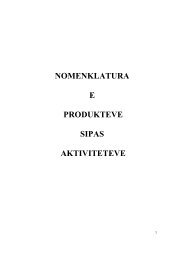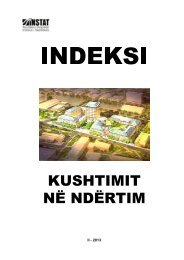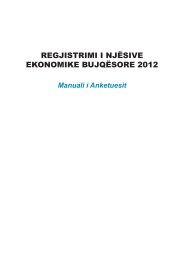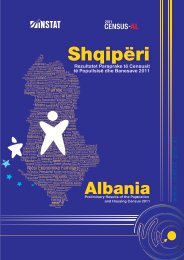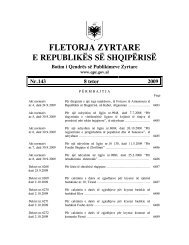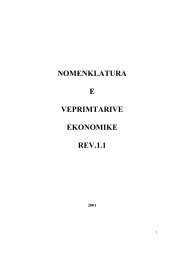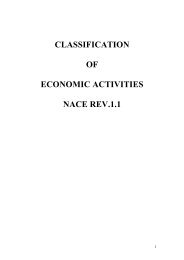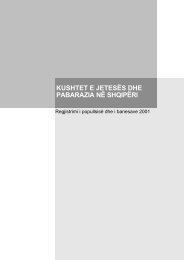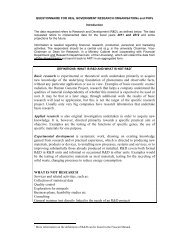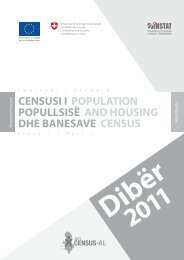Description of methods and sources for Albania - INSTAT
Description of methods and sources for Albania - INSTAT
Description of methods and sources for Albania - INSTAT
- No tags were found...
Create successful ePaper yourself
Turn your PDF publications into a flip-book with our unique Google optimized e-Paper software.
IPA 2009 Multi-beneficiary StatisticalCooperation ProgrammeOther problems are related to the errors <strong>of</strong> the data provided <strong>and</strong> the missing months,which can be identified properly if the analyses are conducted on the individuallevel. After these analyses are conducted, the enterprises can be arranged in groupsbased on NACE 4 classification, <strong>and</strong> then on the classification used by Quarterly <strong>and</strong>Annual National Account concept, 25 industries in total.The next step has to do with the benchmarking process. Benchmarking deals with theissue <strong>of</strong> combining a series <strong>of</strong> high-frequency data with a series <strong>of</strong> lower-frequencydata <strong>for</strong> a certain variable into a consistent time series. Based on this process, thetotal <strong>of</strong> four quarter indicators is equal with the total <strong>of</strong> annual value added, but theprocess does not change the ratio <strong>of</strong> indicator.The indirect method is based on the assumption that the value added/output rate isconstant during the period that we make the estimation. This procedure is done atcurrent <strong>and</strong> constant prices. When quarterly indicators are <strong>of</strong> value oriented, wedeflate those with the respective index, <strong>and</strong> later go through the benchmark processwith two series, both at constant prices.When both quarterly value added series, at current <strong>and</strong> constant prices are produced,we make the aggregation <strong>of</strong> these series in 7 branches <strong>of</strong> the economy. The next stephas to do with the seasonal adjustment. We eliminate seasonal effects from bothseries. After this process, we cannot have exactly the same value between annual <strong>and</strong>quarterly periods <strong>for</strong> a specific year, because <strong>of</strong> seasonal adjustments’ process.18.2.1 Sequence <strong>of</strong> compilationThe general way applied in <strong>Albania</strong> during the indirect method is as follows:a) Data-set <strong>and</strong> balance <strong>of</strong> quarterly data at current <strong>and</strong> constant pricesfrom different <strong>sources</strong> <strong>for</strong> the appropriate recent year.b) Development <strong>of</strong> time series <strong>for</strong> quarterly data so as different periods arecomparable.c) Benchmark <strong>of</strong> the non-seasonally adjusted series to the relevant annualseries.d) Elimination <strong>of</strong> the seasonality from aggregated quarterly seriese) Comparability <strong>of</strong> seasonal series.It should be underlined that there is no requirement <strong>for</strong> the sum <strong>of</strong> seasonallyadjusted quarters to be equal to the annual total <strong>for</strong> any particular year. Under normalcircumstances, there will be enough variation in seasonality <strong>and</strong>/or trading dayeffects to explain a gap between the two.18.2.2 Series expressed in 2005 pricesThe series in this release are expressed in the average prices <strong>of</strong> the year 2005.ItiPA v e r a g etiiP2 0 0 5i163/236



